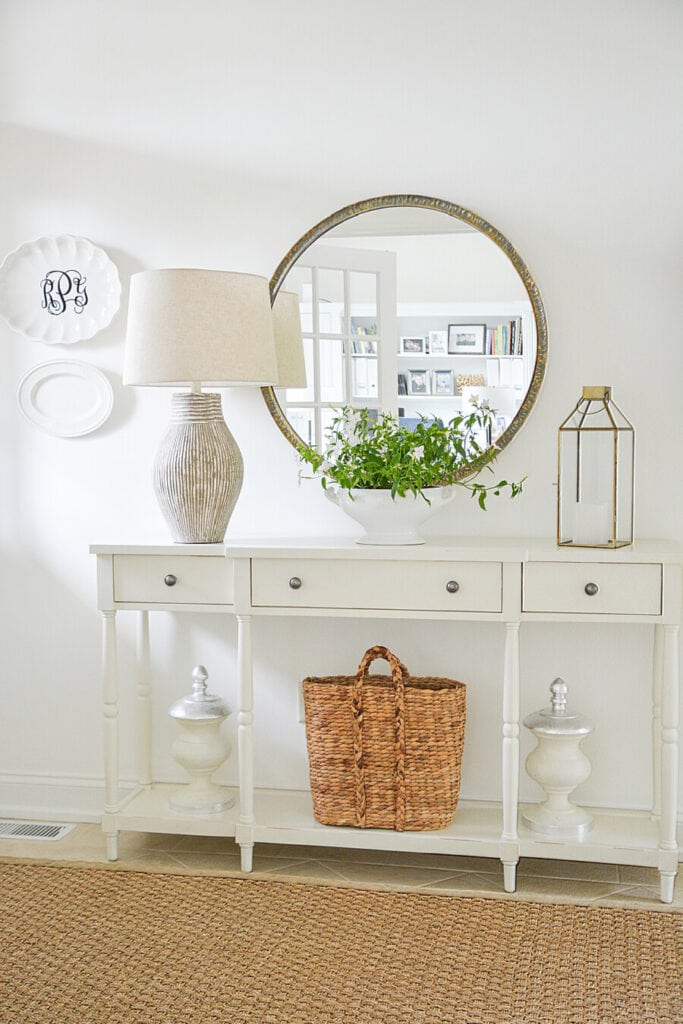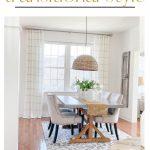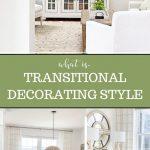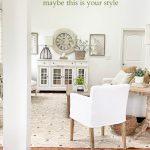Beautiful Transitional Style: This Just Might Be Your Style
Transitional style blends classic and modern elements. Learn how to create a fresh, upscale, and versatile look for your home.
July through the first two weeks of August can be tricky months for blogging! Seasonal decor is mostly wrapped up, and it’s not quite time for fall decorations yet. However, this period is perfect for boosting our decorating IQ before the rush of fall and Christmas. Welcome to DECORATING WEEK! All this week, I’m rewriting and reposting some of the most popular and important “how to decorate” posts to help you become a more confident and skilled decorator!
Decorating Week is part of a larger series called DECORATING SCHOOL. For the next six weeks, I’ll share one or two of the best decorating posts, rich with learning and practical applications with fresh content until mid-August. By the end of this series, you’ll have gone through a comprehensive decorating course that will shine through in your decor!
There is a surprise for everyone who reads all the DECORATING WEEK AND DECORATING SCHOOL posts! So keep reading and learning, and I’ll have more to say about the surprise later! Here’s a little hint: I’d love to hear your comments!
Now for our first decorating post of Decorating Week…
I often get asked, “What is your decorating style?” I like to respond that it’s like vanilla ice cream—appealing to almost everyone. Or it’s like the decor at Pottery Barn. Whether or not you love the decor in my home, the overall style has something for everyone.
My style is Transitional, and perhaps yours is too. It’s a highly popular and adaptable style that encompasses a variety of substyles, including Midcentury, Traditional, Farmhouse, New Tradition, and more. Saying your style is Transitional is really like saying as yummy and versatile as vanilla ice cream.
What is your decorating style? Today, let’s chat about what a Transitional style is and what it means to incorporate it into home decor.
Transitional style is probably the most popular design style right now.
And no wonder! Transitional style is the perfect blend of traditional and contemporary elements combined with various accent styles to create seamless beauty and comfort. It incorporates the formality of traditional styling while remaining comfortable, interesting, and pleasantly familiar in the best possible way.

What makes Transitional style so appealing is its ability to incorporate elements from various other styles as accent decor. So, if you enjoy touches of farmhouse or French decor but don’t want these to dominate your space, then Transitional style is your ideal choice.
What Is Transitional Style

Transitional style is a super category! Imagine it as a large umbrella that encompasses various sub-styles. This style combines numerous design elements at the same time, creating an eclectic look that is far from chaotic. Instead, it is delightfully pleasing to the eye.
Transitional decor strikes a balance between classic decor and a fresh, functional touch. It’s the perfect marriage of tried-and-true home decor styles. The beauty of Transitional style lies in its foundation of timeless, classic decor that never goes out of style. This timelessness is what makes Transitional decor so appealing to me and so many other decorators.
Transitional style embraces updated classics and can always be refreshed with trendy items. It spotlights foundational pieces, great bones, and a color palette that stands the test of time. I love the longevity of this style, which is why I don’t mind investing in classic pieces of furniture.
A Good Working Description Of Transitional Style
Transitional style balances traditional and contemporary elements. It combines the elegance of traditional decor with the clean lines of modern design, resulting in a timeless and versatile look. This style uses neutral colors, simple yet refined furniture, and a mix of textures and materials to create a cohesive and comfortable space.
It is not a trend but rather a classic, beloved decorating style.
How Did Transitional Style Come About
Transitional style came about as a response to our ever-changing tastes and lifestyles. In the 1950s and 1960s, modern and minimalist styles gained popularity, and many people found this style too stark. Yet, people did like the lines of contemporary styling.
Designers and homeowners started mixing classic furniture pieces with modern accessories and finishes. Neutral color palettes became popular for their timeless look, which created a versatile backdrop for many other styles and a decorator’s personal taste. This resulted in a beautiful and inviting aesthetic that combines the familiarity of traditional decor with the freshness and simplicity of contemporary style.
Transitional style continues to evolve and is translated by the individual who decorates in this style. It adapts and changes to our personal tastes while Transtional style keeps its core principles of harmony and timelessness. That is the true beauty and genius of Transitional style!
Characteristics Of Transitional Style
Transitional interiors offer a timeless and balanced look. They are versatile and appealing, creating spaces that are both elegant and comfortable. Here are the key characteristics of a transitional-style home.
- Quality Over Quantity: Focusing on quality pieces rather than filling the Transitional space with many items.
- Neutral and Tone-on-Tone Color Palette: Creams, taupes, grays, with a splash of black.
- Functional Layouts: Prioritizing functional and practical layouts that enhance everyday living.
- Natural Materials: Incorporating natural materials like wood, stone, rattan, marble and metal for a timeless aesthetic.
- Solid Neutral Upholstery: Upholstery in neutral tones with patterns and textures introduced through pillows and throws.
- Abundant Texture: Incorporating various textures to add depth and interest.
- Open and Airy Spaces: Creating open, airy interiors that feel inviting and spacious.
- Subtle Elegance: Emphasize subtle elegance through carefully selected decor and finishes.Soft, Comfortable Fabrics: Soft, comfortable fabrics create a welcoming and cozy atmosphere.
- Repurposed Items: Using items that may have had a different function in the past, like galvanized trays.
- Classic Furnishings with Simple Lines: Choosing classic, timeless furniture with clean, simple silhouettes.
- One Fabulous Focal Point: Creating a standout focal point in each room.
- Interesting Architecture: Highlighting architectural details that add character and interest.
- Modern Fixtures and Hardware: Incorporating modern lighting fixtures and hardware to seamlessly blend old and new elements.
- A mix of Traditional Design and Contemporary Furniture: Blending traditional pieces with modern ones to create a balanced and cohesive look.
- Minimal Accessories: Uses just enough accessories to show off your personality.
5 Transitional Core Principles To Follow Closely
When it comes to interior design, I often say that you can break a few design rules and still create a beautiful space. However, Transitional style is the exception to this rule, my friend!
Although the transitional style has many interpretations, you can always distinguish it because of five must-follow rules. These guidelines are essential to achieving a consistent and attractive Transitional look. Breaking them can result in a disjointed and unbalanced space.
So, let’s take a look at these crucial rules that should never be overlooked if you want to master the art of Transitional design.
Choose A Neutral Color Palette
One of the easiest ways to identify a home with Transitional style is by its color palette. A neutral color palette is quintessential to this style. Think soft whites, beiges, creams, bisques, grays, greiges, tans, browns, charcoals, and even black.
There are countless hues, tones, and shades to choose from within a neutral palette.
When choosing a color palette, remember to
STAY IN YOUR LANE.
These are easy words to remember! What I mean is, choose a color palette and don’t veer off into a multitude of other colors. This is so important when considering transitional interior design!
Choosing a neutral palette creates a cohesive, put-together, and beautiful look. Adding too many colors often creates confusion, especially with Transitional style. If you love a little color, Transitional style can accommodate that too. A single color or maybe two can be used as an accent, but it should be used sparingly and judiciously.
A unified color palette ties the whole home together, creating a seamless flow from room to room. This consistency is key to achieving the balanced and elegant look that defines Transitional style. So, choose your colors carefully and stick to them to maintain the integrity and beauty of your decor.
Texture And Pattern
Transitional style favors fewer patterns compared to Traditional style, which often embraces many intricate patterns. Instead, Transitional style emphasizes texture over pattern to create visual interest and depth.
This doesn’t mean that patterns are completely absent in Transitional decor; they are simply used more sparingly. This versatile style has traded in an abundance of elaborate patterns for a more subtle yet effective choice: texture. By focusing on texture, Transitional style achieves a sophisticated and inviting look without overwhelming the space. This is especially true in smaller or downsized homes like mine.
Texture is king in Transitional style! From woven textiles to natural materials like wood and stone, texture adds warmth and character to your home. Don’t be afraid to layer different textures. Combine a plush velvet sofa with a nubby sisal area rug in your living room, or pair a sleek leather chair with a rough-hewn wooden coffee table. These textural elements create a rich, multi-dimensional look that is both elegant and comfortable.
By prioritizing texture over pattern, Transitional style maintains a clean, cohesive look while still providing plenty of visual interest.
The Best Kept Designer Secret: What You Should Know About Texture will help you add depth and beauty to your home. It’s a design game changer hidden in plain sight.
Choose A Mix Of Old And New

Transitional style shines when foundational furnishings are streamlined and refined. Think of it as putting your furniture on a design diet! Avoid big rolled arms, fringes, and heavy wood pieces. While Transitional style isn’t petite, its furniture lines are edited, giving it a lighter visual weight. Understanding visual weight is crucial for decorators; you can learn more about it in the post Why Knowing About Visual Weight Will Make You A Better Decorator.
Mixing old and new elements is what makes the Transitional style sing! It’s important to ensure that these pieces look proportional to one another. Make sure to check out Why Scale, Balance, And Proportion Are Important In Decorating.
The goal is to blend old and new items seamlessly so they appear as though they belong together. This fusion creates a very attractive and cohesive look that embodies the essence of Transitional style. It’s all about striking the right balance and ensuring that the mix of old and new feels intentional and harmonious.
This is one aspect of Transitional style that is a work in progress for me.
Mix Styles, Not Eras
When decorating in a Transitional style, remember to mix styles, not eras. This means blending elements from different design styles, such as traditional and contemporary, to create a harmonious look. Avoid combining items from vastly different historical periods, like Victorian and mid-century modern, which can create a displeasing or chaotic appearance. Instead, focus on pieces that complement each other and maintain a cohesive aesthetic.
In a Transitional home, you want to ensure that your decor elements work together seamlessly. Think of pairing a sleek, modern sofa with a classic, timeless coffee table or combining contemporary art with traditional frames. This approach creates a balanced, inviting space that feels fresh, comfortable, and familiar. By mixing styles thoughtfully, you can create an upscale and comfortable look that defines Transitional style.
Keep To A Clean Aesthetic
This rule can be tough, but it is a very important rule of Transitional style! In this classic, loving style less is often more. Embrace a clean look and resist the urge to overload your home with accents and furniture. This style thrives on simplicity and balance, so each piece should have a purpose and a place. Avoid clutter and unnecessary items that can make your space feel chaotic and overwhelming.
Think curated instead of cluttered.
The benefits of a clean aesthetic are numerous. A well-edited home feels more spacious, serene, and inviting. It allows the beauty of your carefully chosen pieces to shine and makes your home more functional and easy to maintain. A clean look also enhances the sense of calm and order, creating a peaceful retreat where you can truly relax. So, keep it simple and let your Transitional style home be a breath of fresh air.
Benefits of Decorating in the Transitional Style
Decorating in the Transitional style offers many benefits, including an emphasis on a comfortable, timeless look. Here are some of them.
- Ease of Decorating: The versatile nature of Transitional style makes decorating quite straightforward and enjoyable.
- Flexibility: You can move decor from one room to another without changing the overall aesthetic.
- Timeless Appeal: Transitional style blends classic and modern elements, keeping your home always looking stylish.
- Cohesive Look: A consistent color palette and design create a balanced and unified space.
- Versatility: Suitable for various tastes, it accommodates traditional and contemporary preferences.
- Balanced Aesthetic: Combines elegance and comfort, making your home inviting and sophisticated without feeling stuffy.
- Comfort: Focuses on creating a welcoming and cozy environment with comfortable furnishings.
- Minimalist Elegance: Focuses on clean lines and simple decor, avoiding clutter and creating a serene environment.
- Adaptable: Easily updated with new trends while maintaining its core principles.
- Functional Design: Prioritizes practicality and comfort, ensuring that your home is both beautiful and livable.
- Enduring Style: Transitional decor remains relevant over time, providing a lasting and attractive home environment.
Transitional style offers a beautiful, neutral canvas that can be tailored to suit any aesthetic, making it a favorite among homeowners and designers alike.
Related Posts
How To Choose A Color Palette For Your Home
5 Steps For Finding Your Unique Decorating Style And How To Use It In Your Home
Understanding Decorating With The Color Beige
7 Designer Tips For Decorating With Neutrals
Common Questions About Transitional Style
What is the difference between Traditional and Transitional styles?
Traditional style focuses on classic, ornate designs with rich colors and detailed patterns. Transitional style blends Traditional elements with modern, clean lines and neutral colors for a balanced, updated look.
How does Transitional and Modern styles differ?
Transitional style blends traditional and contemporary elements with neutral colors and comfortable textures. Modern style features clean lines and minimal decor.
Is Transitional Style In Style?
Yes, Transitional style is in style. It combines timeless design with modern simplicity, making it a popular and versatile choice.
Happy Decorating, Friends!













I love this article it was very helpful. I am working hard to neutralize my palette. That said is the zebra pillow in the chair available online?
Good morning! I started my “transition” to “transitional” several years ago. I started by eliminating several traditional pieces of furniture – wing chairs, heavy rolled arm chair-and-a-half, and a leather chair. Also, I eliminated the top of an Ethan Allen hutch – very colonial – and painted the base. The only expensive purchase we made was 2 new transitional leather chairs for our family room. Then the fun started – I started by getting rid of all my old bell shape lamp shades and now use white drum shades. We bought all new lighting in the dining room and kitchen. I can’t believe what an impact that made. My draperies are all creamy white throughout the entire house, with brushed gold rods so I didn’t have to do anything with them. I wanted to add more white in the decor so I started buying new white accessories throughout the house to create good flow. I also reframed some artwork in simple brushed gold frames, and eliminated some of the artwork. This process updated our colonial, and it also gave my husband and I a lift at the same time. We have just ordered a new small more contemporary patio set for 2, and this year’s floral theme on our small “dining” patio is all white.
I love transitional and rhat’s my goal to get farther into it. Does the whole house have to be transitional? I have some pieces that I love and they are not in the pale neutral color palette. Any way to do this?
Thanks for joining Tuesday Turn About link party this week Yvonne!
Such a pretty room, Yvonne! I absolutely love your throw pillow fabrics paired together! Gorgeous!!
Fixed,Kim!
Thanks so much, Kim!
Hi! I love this room and have a question about the rug in the living room. Can you tell me where you found it? I found it on the internet at one time, but can’t seem to locate it again. 🙂 Thanks!
Here you go Shelly:https://rstyle.me/+DF9OcYN_rlfzShtOr5HJgw
I so enjoy your blog and all of the inspirational pictures of your beautiful home! It really helps me to look at my own home with fresh ideas. God bless you for sharing your talent!
This is so wonderful to hear Janet! My passion is to help home decorators create a beautiful home.
I really like the transitional style concept. We live in Florida and it works well here
Great! I hope you found some ideas and inspiration here.
I love reading your blog and seeing pictures of your lovely house. It’s a great way to get a new perspective on my own home. Thanks for sharing your talents with the world!
Love the basket weave is it hard to keep clean? Getting ready to do my kitchen. Yours is a inspiration. ?
Like any natural stone backsplash with grout, it is a bit more work. My contractor put something over the backsplash to keep kitchen messes from penetrating it.
Reading this post.. I said to myself, “yes, my style is transitional, but mine is the dark side of transitional.” We live in the country, raise cattle, and lour home is a ranch style house. I live with ‘men-folk’ that work hard all day, outside… my cherished sofa is the Brooklyn Sofa by Pottery Barn in dark brown leather… purchased at the outlet years ago. My big furniture pieces are dark walnut wood… so how’d I get to transitional? My coffee table and side table are glass & antique brass. My lamps are Crome & glass with cream colored drum shades…. my color palette is brown, grey, cream and soft pink. I know it may sound horrible, but it’s actually beautiful and has converted a very masculine room into a room my feminine sensibilities feel at home in. You are an inspiration and I love reading your blog!
I LOVE that color palette. And decorating styles are interpreted in so many beautiful colors. the sofa sound amazing!
I’ve learned so much from your ideas visually posted! After updating 3 bedrooms, bath and kitchen in my childhood home built in 1953, we’re about to tackle a living-dining-entry area. My concern is keeping a fireplace as a focal point. I love its natural brown-red brick. However, its heavily varnished maple mantle is questionable. Oak floor will be refurbished. Wall bookshelf which is also varnished will be painted neutral same as walls. What suggestion do you have for the fireplace mantle?
Maybe the mantel should be the same color as your floors?
To put it simply, I adore the idea of a transitional style. We put it to good use in sunny Georgia.
What an informative post! I now have a name to my style. Transitional 😊. We downsized to a condo in SW FL from the Northeast. Our place is a work in progress but getting there. I have been stopped in my tracks at times knowing something just is not jiving. I plan to print out these Principles going forward to use as my guide. After reading this post , I’ve identified where I need to go next.
You’re the best!
What a smart idea, Brendine! Happy dcorating and much joy and love in your new home.
I have followed you for awhile now, & have also read this article before. But somehow, it dawned on me this time thru that my style is actually transitional! I felt like I was be-bopping around, but it worked & I couldn’t understand why! Silly. I mix european farmhouse (a little french with curlicues in brushed gold in light fixtures & fireclay sinks), american farmhouse (black accents, a little black goes a long way & a couple of big word signs & repurposed old doors on the pantry & laundry room), old wood stained family furniture with painted pieces, chrome faucets, a neutral color palette with small doses of an accent color or two (blue is a given here, in very small doses & usually a bit of a 2nd accent color, depending on the season), lots of big windows, white white white with medium toned wood. I have fun “playing house”, changing things up, switching stuff from room to room. New downsize build, big permanent elements are the same throughout which makes things easy. Thanks for making me realize that I really have a “style”, not just a mishmash! I look forward to the next few weeks of articles. Wonder what else I’ll learn!
Hi Kathleen, I added so much new info to this post. Maybe Transitional style was explained better in this update. I’m thrilled you enjoyed this post and it created a lightbulb moment.
We have lived in our home in North Carolina for five years now. It has been a slow process changing to a transitional style. You have inspired me in so many ways and I appreciate how you share your talent as a decorator and spiritual gifts with us. I love your style and your home is beautiful! Now, if you could only come to my house and help me in person!!
I’m so happy to hear this Rebecca! This makes me want to share more.